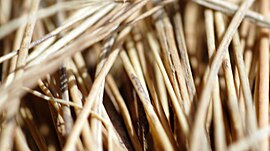
A bristle is a stiff hair or feather (natural or artificial), either on an animal, such as a pig, a plant, or on a tool such as a brush or broom.

A bristle is a stiff hair or feather (natural or artificial), either on an animal, such as a pig, a plant, or on a tool such as a brush or broom.

Synthetic materials such as nylon are also used to make bristles in items such as brooms and sweepers. Bristles are often used to make brushes for cleaning purposes, as they are strongly abrasive; common examples include the toothbrush and toilet brush. The bristle brush and the scrub brush are common household cleaning tools, often used to remove dirt or grease from pots and pans. Bristles are also used on brushes other than for cleaning, notably paintbrushes.
Bristles are distinguished as flagged (split, bushy ends) or unflagged; these are also known as flocked or unflocked bristles. [1] In cleaning applications, flagged bristles are suited for dry cleaning (due to picking up dust better than unflagged), and unflagged suited for wet cleaning (due to flagged ends becoming dirty and matted when wet). [2] In painting, flagged bristles yield more even application. [3]
Bristles are found on pig breeds, instead of fur. Because the density is less than with fur, pigs are vulnerable to sunburn. One breed, the Tamworth pig, is endowed with a very dense bristle structure such that sunburn damage to skin is minimized. Animals named for their bristles include bristlebirds, the bristle-thighed curlew, the bristle-spined porcupine, and the Trinity bristle snail. Bristles also anchor worms to the soil to help them move.

Oil painting is a painting method involving the procedure of painting with pigments with a medium of drying oil as the binder. It has been the most common technique for artistic painting on canvas, wood panel or copper for several centuries, spreading from Europe to the rest of the world. The advantages of oil for painting images include "greater flexibility, richer and denser color, the use of layers, and a wider range from light to dark". But the process is slower, especially when one layer of paint needs to be allowed to dry before another is applied.

A broom is a cleaning tool consisting of usually stiff fibers attached to, and roughly parallel to, a cylindrical handle, the broomstick. It is thus a variety of brush with a long handle. It is commonly used in combination with a dustpan.

A toothbrush is a special type of brush used to clean the teeth, gums, and tongue. It consists of a head of tightly clustered bristles, atop of which toothpaste can be applied, mounted on a handle which facilitates the cleaning of hard-to-reach areas of the mouth. They should be used in conjunction with something to clean between the teeth where the bristles of the toothbrush cannot reach - for example floss, tape or interdental brushes.
A brush is a common tool with bristles, wire or other filaments. It generally consists of a handle or block to which filaments are affixed in either a parallel or perpendicular orientation, depending on the way the brush is to be gripped during use. The material of both the block and bristles or filaments is chosen to withstand hazards of its intended use, such as corrosive chemicals, heat or abrasion. It is used for cleaning, grooming hair, make up, painting, surface finishing and for many other purposes. It is one of the most basic and versatile tools in use today, and the average household may contain several dozen varieties.

A hairbrush is a brush with rigid or light and soft spokes used in hair care for smoothing, styling, and detangling human hair, or for grooming an animal's fur. It can also be used for styling in combination with a curling iron or hair dryer.

A kolinsky sable-hair brush is a fine artists' paintbrush.

The Gloucestershire Old Spots is an English breed of pig which is predominantly white with black spots. It is named after the county of Gloucestershire. The Gloucestershire Old Spots pig is known for its docility, intelligence, prolificity, and hardiness. Boars reach a mature weight of 600 lb (272 kg) and sows 500 lb (227 kg). The pigs are white with clearly defined black spots. There must be at least one spot on the body to be accepted in the registry. The breed's maternal skills enable it to raise large litters of piglets on pasture. Its disposition and self‑sufficiency should make it attractive for farmers raising pasture pigs and those who want to add pigs to diversified operations.

Plasterwork is construction or ornamentation done with plaster, such as a layer of plaster on an interior or exterior wall structure, or plaster decorative moldings on ceilings or walls. This is also sometimes called pargeting. The process of creating plasterwork, called plastering or rendering, has been used in building construction for centuries. For the art history of three-dimensional plaster, see stucco.
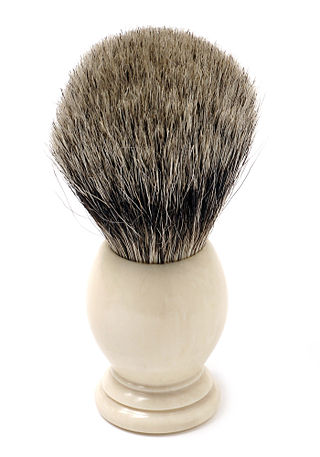
A shaving brush or shave brush is a small brush with a handle parallel to the bristles used to make lather from shaving soap or shaving cream and apply it to the face when shaving. Shave brushes are often decorative; antique handles are often made from materials such as ivory or even gold, though the bristle load may be composed of any number of natural or synthetic materials. The shave brush is used most often today by "wet shavers" in tandem with a single- or double-edged safety razor or a straight razor. However, this is not always the case, as shavers of all varieties may employ the tool.

Carpet cleaning is performed to remove stains, dirt, debris, and allergens from carpets. Common methods include hot water extraction, dry-cleaning, and vacuuming.

Horse grooming is hygienic care given to a horse, or a process by which the horse's physical appearance is enhanced for horse shows or other types of competition.
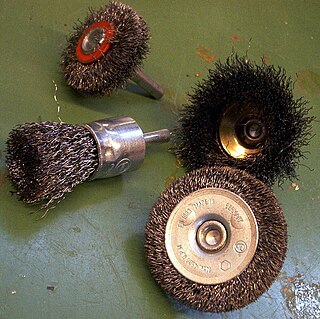
A wire brush is a tool consisting of a brush whose bristles are made of wire, most often steel wire. The steel used is generally a medium- to high-carbon variety and very hard and springy. Other wire brushes feature bristles made from brass or stainless steel, depending on application. Wires in a wire brush can be held together by epoxy, staples, or other binding. Wire brushes usually either have a handle of wood or plastic or are formed into a wheel for use on angle grinders, bench grinders, pistol-grip drill motors, or other power tools.
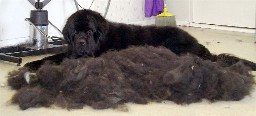
Dog grooming refers to the hygienic care of a dog, a process by which a dog's physical appearance is enhanced. A dog groomer is a professional that is responsible for maintaining a dog’s hygiene and appearance by offering services such as bathing, brushing, hair trimming, nail clipping and ear cleaning.
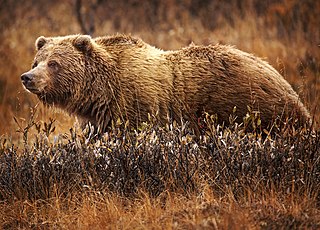
Fur is a thick growth of hair that covers the skin of almost all mammals. It consists of a combination of oily guard hair on top and thick underfur beneath. The guard hair keeps moisture from reaching the skin; the underfur acts as an insulating blanket that keeps the animal warm.
Hairstyling tools may include hair irons, hair dryers, hairbrushes, hair rollers, diffusers and various types of scissors.

A makeup brush is a tool with bristles, used for the application of makeup or face painting. The bristles may be made out of natural or synthetic materials, while the handle is usually made out of plastic or wood. When cosmetics are applied using the appropriate brush, they blend better onto the skin.
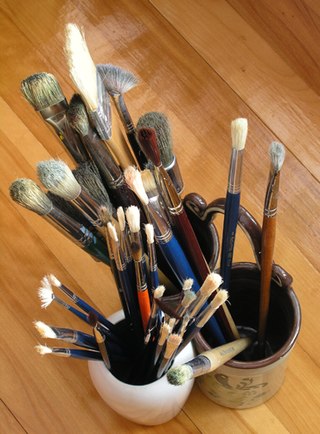
A paintbrush is a brush used to apply paint or ink. A paintbrush is usually made by clamping bristles to a handle with a ferrule. They are available in various sizes, shapes, and materials. Thicker ones are used for filling in, and thinner ones are used for details. They may be subdivided into decorators' brushes used for painting and decorating and artists' brushes use for visual art.
The conservation and restoration of leather objects is the process of determining the causes of deterioration, followed by deciding the best course of action for preserving the leather objects for the future.

A camel-hair brush is a type of paintbrush with soft bristles made from natural hairs, usually squirrel. Actual camel hair is not a suitable material, although historically camel was used for ancient Chinese ink brushes. It is a widely used brush in art, but is considered inferior to the more expensive sable and ox-hair brushes. In some niche applications, such as pinstriping, camel hair is an ideal brush. Camel-hair brushes have numerous uses outside of art, particularly dusting where a soft brush is needed for delicate objects or skin.
The conservation and restoration of fur objects is the preservation and protection of objects made from or containing fur. These pieces can include personal items like fur clothing or objects of cultural heritage that are housed in museums and collections. When dealing with the latter, a conservator-restorer often handles their care, whereas, for the public, professional furriers can be found in many neighborhoods.